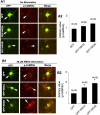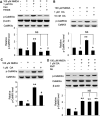Bi-directional regulation of CaMKIIα phosphorylation at Thr286 by NMDA receptors in cultured cortical neurons
- PMID: 22582824
- PMCID: PMC3434305
- DOI: 10.1111/j.1471-4159.2012.07787.x
Bi-directional regulation of CaMKIIα phosphorylation at Thr286 by NMDA receptors in cultured cortical neurons
Abstract
The N-methyl-D-aspartate (NMDA) receptor (NMDAR)-stimulated autophosphorylation of calmodulin-dependent kinase IIα at Thr286 may regulate many aspects of neuroplasticity. Here, we show that low NMDA concentration (20 μM) up-regulated Thr286 phosphorylation, and high concentration (100 μM) caused dephosphorylation. We next modulated the strength of NMDAR activation by manipulating NMDAR 2A subunit (NR2A) and NMDAR 2B subunit (NR2B), which represent the major NMDAR subtypes in forebrain regions. Pharmacological inhibition and molecular knockdown of NR2A or NR2B blocked 20 μM NMDA-induced phosphorylation. Conversely, over-expression of NR2A or NR2B enhanced phosphorylation by 20 μM NMDA. The 100 μM NMDA-induced dephosphorylation was suppressed by inhibition or knockdown of NR2A or NR2B, and enhanced by over-expression of NR2A or NR2B. Compared to NR2A, NR2B showed a higher impact on the NMDA-stimulated bi-directional regulation of Thr286 phosphorylation. We further found that activation of NR2A and NR2B by 100 μM NMDA-induced dephosphorylation through protein phosphatases (PP) that are inhibited by high concentration okadaic acid (1 μM), but not by PP2A and PP2B inhibitors. This novel function of NMDAR in dynamic regulation of calmodulin-dependent kinase IIα activity provides new evidence to support the current understanding that, depending on the degree of activation, NMDAR may lead to different and even opposing effects on intracellular signaling.
© 2012 The Authors. Journal of Neurochemistry © 2012 International Society for Neurochemistry.
Figures








Similar articles
-
Autophosphorylated calcium/calmodulin-dependent protein kinase II alpha (CaMKII alpha) reversibly targets to and phosphorylates N-methyl-D-aspartate receptor subunit 2B (NR2B) in cerebral ischemia and reperfusion in hippocampus of rats.Brain Res. 2003 Mar 28;967(1-2):161-9. doi: 10.1016/s0006-8993(02)04267-1. Brain Res. 2003. PMID: 12650977
-
NR2B-NMDA receptor-mediated increases in intracellular Ca2+ concentration regulate the tyrosine phosphatase, STEP, and ERK MAP kinase signaling.J Neurochem. 2010 Aug;114(4):1107-18. doi: 10.1111/j.1471-4159.2010.06835.x. Epub 2010 May 28. J Neurochem. 2010. PMID: 20524968 Free PMC article.
-
Phosphorylation status of the NR2B subunit of NMDA receptor regulates its interaction with calcium/calmodulin-dependent protein kinase II.J Neurochem. 2009 Jul;110(1):92-105. doi: 10.1111/j.1471-4159.2009.06108.x. Epub 2009 Apr 21. J Neurochem. 2009. PMID: 19453375
-
The NR2B subtype of NMDA receptor: a potential target for the treatment of alcohol dependence.Curr Drug Targets CNS Neurol Disord. 2004 Jun;3(3):169-79. doi: 10.2174/1568007043337409. Curr Drug Targets CNS Neurol Disord. 2004. PMID: 15180478 Review.
-
Regulation of NMDA Receptors by Kinases and Phosphatases.In: Van Dongen AM, editor. Biology of the NMDA Receptor. Boca Raton (FL): CRC Press/Taylor & Francis; 2009. Chapter 7. In: Van Dongen AM, editor. Biology of the NMDA Receptor. Boca Raton (FL): CRC Press/Taylor & Francis; 2009. Chapter 7. PMID: 21204420 Free Books & Documents. Review.
Cited by
-
Involvement of the GluN2A and GluN2B subunits in synaptic and extrasynaptic N-methyl-D-aspartate receptor function and neuronal excitotoxicity.J Biol Chem. 2013 Aug 16;288(33):24151-9. doi: 10.1074/jbc.M113.482000. Epub 2013 Jul 9. J Biol Chem. 2013. PMID: 23839940 Free PMC article.
-
Investigating the role of Ca2+/calmodulin-dependent protein kinase II in the survival of retinal ganglion cells.Neural Regen Res. 2022 May;17(5):1001-1002. doi: 10.4103/1673-5374.324844. Neural Regen Res. 2022. PMID: 34558519 Free PMC article. No abstract available.
-
MiR-219 Protects Against Seizure in the Kainic Acid Model of Epilepsy.Mol Neurobiol. 2016 Jan;53(1):1-7. doi: 10.1007/s12035-014-8981-5. Epub 2014 Nov 15. Mol Neurobiol. 2016. PMID: 25394384
-
Basic roles of key molecules connected with NMDAR signaling pathway on regulating learning and memory and synaptic plasticity.Mil Med Res. 2016 Aug 31;3(1):26. doi: 10.1186/s40779-016-0095-0. eCollection 2016. Mil Med Res. 2016. PMID: 27583167 Free PMC article. Review.
-
Thalamo-cortical axons regulate the radial dispersion of neocortical GABAergic interneurons.Elife. 2016 Dec 9;5:e20770. doi: 10.7554/eLife.20770. Elife. 2016. PMID: 27935475 Free PMC article.
References
-
- Barria A, Malinow R. NMDA receptor subunit composition controls synaptic plasticity by regulating binding to CaMKII. Neuron. 2005;48:289–301. - PubMed
-
- Bayer KU, De Koninck P, Leonard AS, Hell JW, Schulman H. Interaction with the NMDA receptor locks CaMKII in an active conformation. Nature. 2001;411:801–805. - PubMed
Publication types
MeSH terms
Substances
Grants and funding
LinkOut - more resources
Full Text Sources
Miscellaneous

